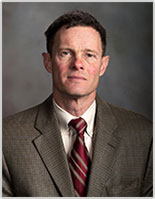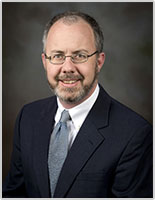PROFESSOR Q&As

Randolph Wynne, professor of forestry and remote sensing in the College of Natural Resources and Environment, is a member of the national Landsat Science Team, a group of scientists and engineers that provides technical and scientific input on issues critical to the success of Landsat, a series of U.S. scientific satellites that has been compiling images of the Earth's surface for 40 years. He also coordinates the Department of Forest Resources and Environmental Conservation's new major in environmental informatics, which applies information science to the management of natural resources—using such tools as computer science, geographic information systems, remote sensing, database management, and data visualization and modeling—in order to instill environmental problem-solving skills in students.
Pictures from space provide a supplemental, bird's-eye view of the landscape that, when used with data collected on the ground, helps us figure out what is happening to our forests and why.
The additional information we get from remote sensing is now integrated into forest management decisions made by almost every organization charged with managing forests. In one example, trees killed by insect outbreaks, like the mountain pine beetle, can be identified to better understand the fire risk in suburban neighborhoods.
The main thing that we can now know is where we are losing forests and where we are gaining them. We can find out where parks and other protected areas are really working to preserve forests and where they are not. In addition, if the forest is intensively managed, we can use information we get from remote sensing to help the trees grow better and therefore absorb more carbon from the atmosphere. For example, if our satellite pictures show us there are fewer leaves on the trees than there should be, we can fertilize to reduce nutrient limitations.
Big-data analytics is one of the fastest-growing careers worldwide—and the many organizations charged with environmental and natural-resource management will be hiring.
The club leadership in the past couple of years has focused on building a more competitive intercollegiate presence while also providing a program for members of the university community who want to be exposed to the joy of sailing without competing. I am excited to be part of a growing program that builds on the legacy of many prior student leaders and former advisor Shep Zedaker.

Mark Embree (mathematics, computer science '96), a professor of mathematics in the College of Science, is one of only two Virginia Tech alumni—along with William Lewis (physics '63)—who can call themselves Rhodes Scholars. When Embree left Rice University and returned to Blacksburg in 2014, his reason wasn't for the Hokie Stone—it was to help start a brand-new program that he's sure will make its mark on the university and the lives of students: computational modeling and data analytics.
There is a buzz among students, particularly younger students, when they hear about this. And, quite honestly, there has been a buzz among industry executives we've spoken to. They often say, "Can I hire your first 10 graduates?" That reaction confirms our intuition: There is a need for graduates with interdisciplinary skills in mathematics, statistics, and computer science. Virginia Tech has a great team of faculty members that believes in this mission and is collaborating to make it happen.
It's essentially about algorithms, mathematical modeling, and big data. Our society creates an enormous amount of data. The new Goodwin Hall is an excellent example: It houses 241 sensors that record about four gigabytes of data every hour. But what do you do with it all? How do you make sense of such vast information? The CMDA program will prepare students to use mathematical analysis, statistics, and high-performance computing to determine the appropriate data for the problem that's being solved and then to collect the data, clean it, and create a computational model that provides useful, actionable information to the client.
We must emphasize ethics. Mathematical models are often consumed by clients who are unable to question the details. Our students must learn to be clear and honest about assumptions, uncertainties, and the limits of their models, particularly when these models recommend some course of action to industry or policymakers. These lessons are best learned in context, so CMDA majors will undertake serious, client-driven capstone projects. They will work with real data, in all its messiness, and present a final model to the project's client. Good internships will also be vital.
The list of potential jobs that could use the skills we will teach through the CMDA program is exhaustive. Many exciting startups in Silicon Valley are starving for this talent. They are interested in the best algorithms, and they need employees who understand the cutting edge, not button-pushers using canned software. Anyone who hires engineers needs the skills our students will have, and employers won't find many undergraduates in the country who have them. One industry member told me, "We need these people; we write job descriptions for this and can't hire anyone." Our team is eager to address this issue.
School of Visual Arts Associate Professor Eric Standley has gained international acclaim for his artwork: "drawings" composed of hundreds of intricate layers of laser-cut colored paper, stacked together to create pieces that, at first glance, resemble stained glass, but reveal hidden details with each new viewing. Standley, who teaches classes on laser cutting, engraving, and the principles of art and design, has been invited to participate in the prestigious CODA Paper Art Biennial and has an upcoming solo show at the Virginia Museum of Contemporary Art in Virginia Beach, Virginia.
In 2005, I had this brilliant idea that I would cut Cheerios boxes to sort of elevate the banal. So I began to intricately cut these things, and it was going pretty well for a somewhat sarcastic project; and then one day when I was leaving, I stacked a bunch of these cuts on top of each other and was blown away by the complexities that all the layers created. I began wondering if I could consciously think about these layers as they receive depth. And that question hung on my shoulder for a year or two until I started working it through.
Yep. Cereal boxes. Nutrition facts, specifically.
I can be conscious of 10 layers at one time and work my drawing around that. I don't even think of this as layers so much anymore as I am drawing; I think about the negative space I'm creating as I go. The process takes months. Last year, I did one work that took me 10 months to draw. I was averaging 50 hours a week on that. It was an obsessive work.
I try to create a learning environment where I guide them through thinking about themselves and about why they would do something. In my mind, you have to know yourself first before you can express yourself, or you are just illustrating stuff.
I love introducing the laser to the students. It's an answer waiting for a problem. Technology is built to solve problems we already have. Like, how can I cut cardboard boxes better? A laser. As artists, it is our responsibility to creatively look at these tools and figure out how we can use them in ways that are completely new.
I am in a band called Train Fare Home. We play rock 'n' roll and a lot of blues with a bit of Allman Brothers style—we call it Appalachian voodoo. I find myself getting geeky and techy, but for the most part, I try not to analyze the music like I do my art, so it's a recreation for me. I also coach my 8-year-old son's soccer team, the Orange Unicorns.

Produced by University Relations